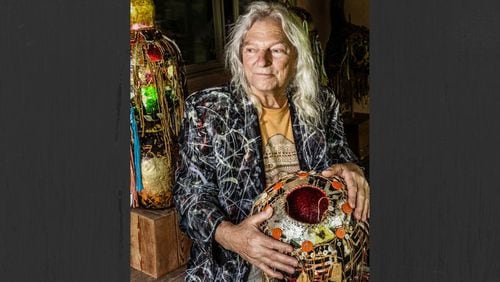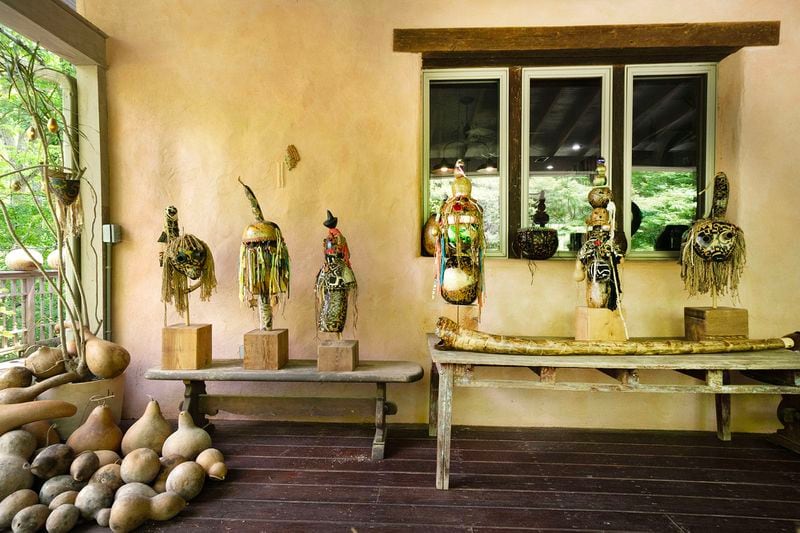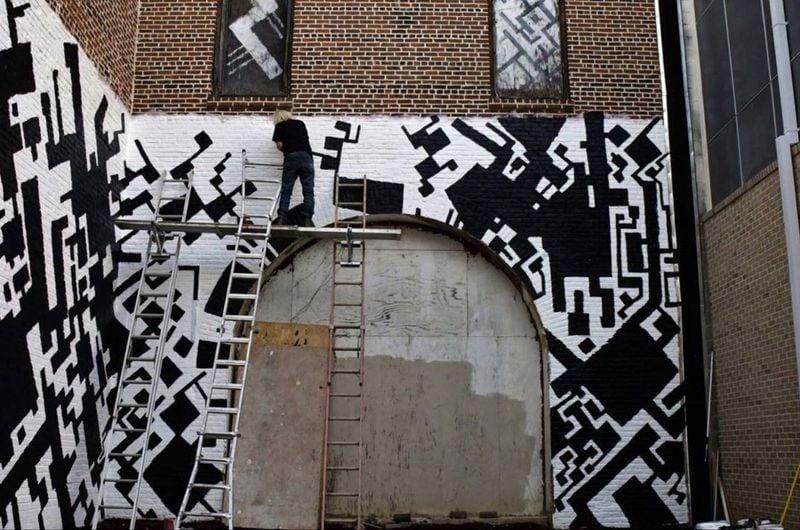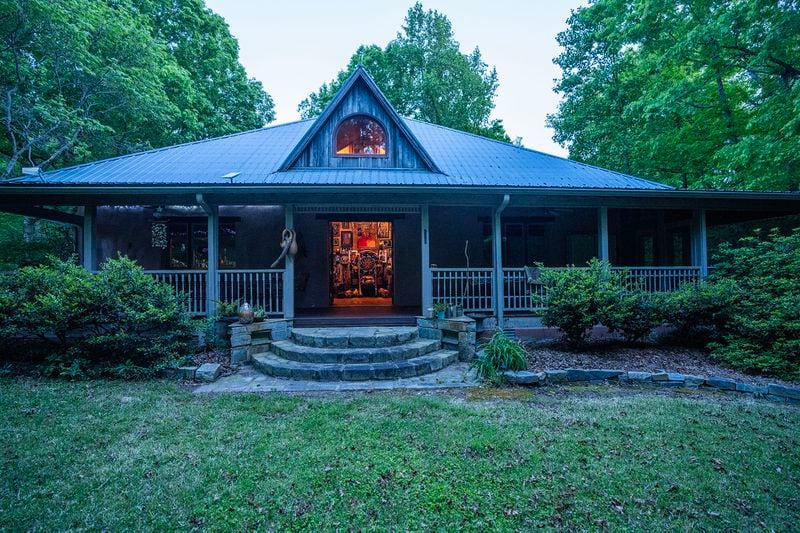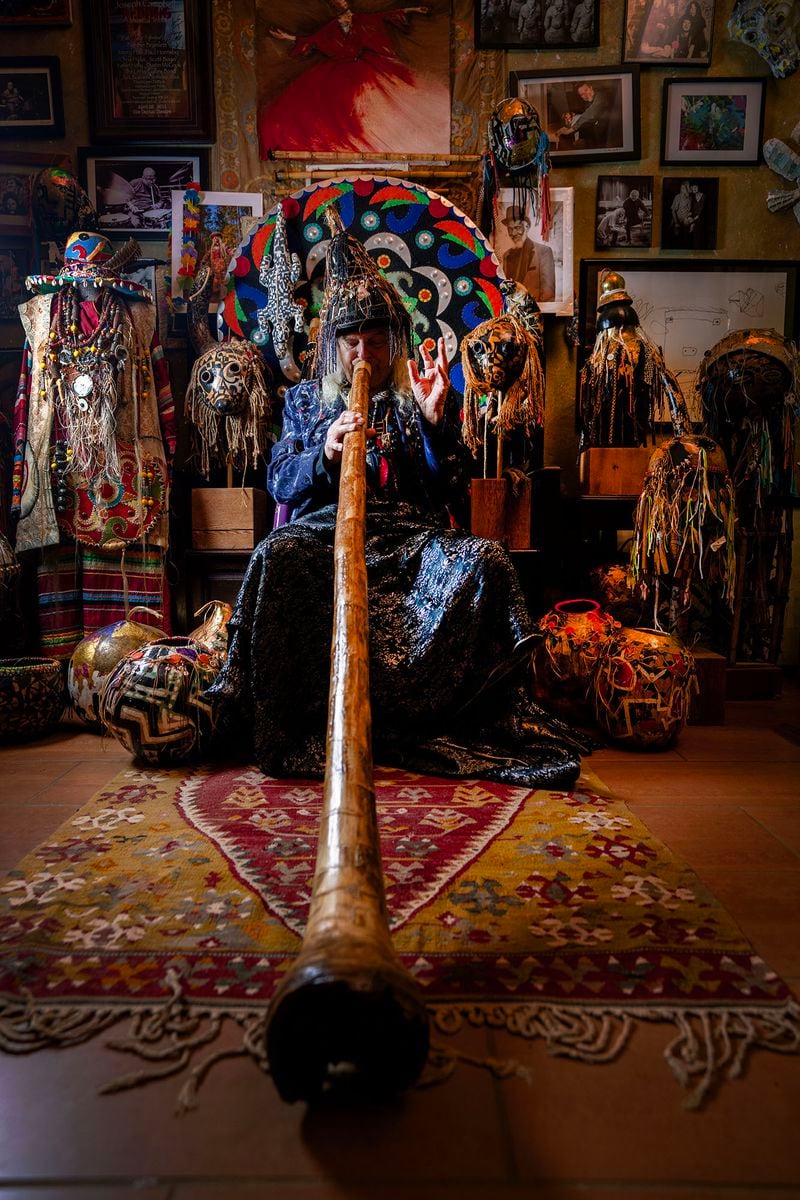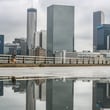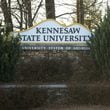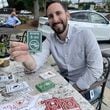The Italian novelist Italo Calvino once wrote that “each life is an encyclopedia, a library.” If so, the library of 72-year-old artist Michael Pierce is filled with fantastical tales that span the dawn of Southern rock; a night job making tofu sandwiches for the likes of The Grateful Dead; tours of India, America and Canada in a converted city bus; a close call with a cop in Karachi, Pakistan, who could have thrown him in jail but impulsively let him go; and for decades now, a quiet, sylvan life in the straw bale home he and his wife, Elise Lang, built on 44 acres in Farmington, 20 miles south of Athens.
“Michael is an inspiration to other artists because he’s such an original,” says fellow artist John Mollica, who last year won an award from the Macon Arts Alliance for his work promoting local artists and musicians. “He has that magical thing most people don’t have, that he was born to make art. Art chose him right from the beginning.”
Pierce’s riotously colorful works include murals, decorative gourds, metalwork, sculpture, salvaged materials and wearable art, and they blend elements of the tribal, mystical and surreal. Working across multiple mediums — leather, fabric, burlap, canvas, plants and the human body, which he sometimes paints like a canvas — he exhibits at Farmington’s Depot Gallery, the Oconee Cultural Arts Foundation in Watkinsville, Grant’s Lounge in Macon, as well as art fairs and blues festivals in Savannah and Macon.
His murals decorate both the interior and exterior of the newly restored iconic Capricorn Recording Studios in Macon. His decorative gourds — which he grows and cleans and transforms by the hundreds — range from the elegant to the primordial, serving as everything from dry vases to tribal headdresses.
“I love gourds,” he says. “They are one of the oldest cultivated plants on the planet, meant to be empty and hold water and carry things, and I love that.”
Credit: terry allen
Credit: terry allen
Forging a path of his own
Pierce decided to be an artist around age 8. “That’s when I met the chief of the Seminole Indians. He showed up at the lake in Macon near where I grew up and where I loved to swim. I followed him around all weekend. He was my first hero, and he is where my idea of art began, with his colorful robes and headdress.”
At 18, Pierce headed off to the Atlanta Institute of Professional Arts (precursor to the now-shuttered Art Institute of Atlanta) to get a graphic design degree, but he gave back his diploma when he left two years later.
“I went into the office and I handed them the diploma and said, ‘I won’t be needing this.’ I knew I was never going to be a commercial graphic artist.”
For years he was an impulsive, international traveler, crisscrossing America, Europe and India, letting the currents carry him — moved by what might seem impulse but he felt was destiny, and always his luck held. There was that time, he recalls, when he boarded a train to Quetta, Pakistan, packed with the Mujahedeen, Islamic guerrilla fighters.
He had only 15 cents in his pocket and was blissfully unaware of the danger he might be in. When he safely disembarked he saw “two rickshaws and my friends waiting with open arms and big smiles. And then we drove 1,500 miles down a narrow, bumpy, rural road to India, where we met a guru and spent time in a remote village filming five generations of Indian musicians.”
One of Pierce’s most profound influences, he says, was the “outsider” artist Eddie Owens Martin (who went by the acronym St. EOM). He spent three decades creating a seven-acre art installation outside Buena Vista, complete with 900 feet of elaborately painted masonry walls, mandala murals and totemic sculptures. The space, known as Pasaquan, is now a tourist attraction on the National Register of Historic Places.
“Eddie influenced me to be true to myself. He’d had a stint as a fortune teller in New York City, and I once asked him to read my fortune. He just said, ‘Man, you know what your fortune is.’ And I took that as a vote of confidence that I could trust myself and I knew my path.”
Credit: David Byrd
Credit: David Byrd
Capricorn rising
Pierce’s best-known artworks are the large murals he painted for Macon’s fabled Capricorn studios, considered the birthplace of Southern rock.
“I had gotten to know the Marshall Tucker Band after they signed a contract with the studio in the ‘70s,” he recalls, “and I would hang out with them while they were recording.”
Two decades later, in the 1990′s, long after the studio had closed and the grounds were in disrepair, “Alan Walden asked me to come up and paint the wall upstairs, which he had turned into an apartment,” recalls Pierce. “It was a huge room originally planned as Otis Redding’s studio. I basically locked myself in the room all weekend and painted.”
Pierce also painted the outside of the old building to mark an Earth Day celebration in the mid ‘90s at the request of environmentalist John Wilson. His mural of syncopated, cubist black-and-white stripes and strokes stretched 155 feet.
“I’ve known Michael since I was 25,” says Wilson, “and everybody loves him. He can fit in anywhere, he’s just done so many things and traveled so much. And he can work in almost any medium.” Wilson believes those murals drew attention to the building and helped save it. “The music was gone, but the art enriched the property and created momentum and vision.”
In 2022, the studio reopened as Mercer Music at Capricorn, with state of the art recording studios, a music incubator and a museum, and Pierce was tapped by architect Bob Brown to touch up the murals.
“Nobody had been inside for years,” Brown recalls, “and the plaster had deteriorated. I was just expecting some light touchup work, but Michael repainted the whole thing. It looks amazing. I’m a big fan.”
To Pierce, repainting the murals was like telling the same story twice, but with a twist. “I’m telling the story again in paint, but with a new inflection,” he explains. “There’s a lot of history in this building.”
Credit: terry allen
Credit: terry allen
Home sweet home
A visit to Pierce’s 2400-square-foot straw bale home, with its pitched metal roof and quiet airy interior, requires a drive up a mile-long dirt driveway. He usually walks down the driveway a few hundred yards to greet his guests, cutting a striking figure with his 6′1″ frame, white tresses and a ready smile.
“This house has a kind of force field,” he says as he takes his visitors on a tour, “that makes you not want to leave it.” Indeed, there is a hushed, earthy silence, almost cathedral like, inside the home due to the sound-absorbing quality of the straw behind plaster walls.
Art, his own and that of others, is everywhere. The foyer atrium boasts 20-foot ceilings and a “truth window” — a small pane of glass set into the plaster wall that reveals the wheat straw packed behind it. The bedroom has what may be the tallest closets in Georgia — designed with 11-foot high pocket doors that were freebies from a mansion in Mississippi. The home’s heart pine floors were crafted from old factory beams.
On a table on the long, deep porch, there is an “oracle rock” — the name he gave to a hunk of stone dug up on a neighbor’s property, with concentric circles that suggest it may have been used by native Americans in rituals. “I traded a huge, beautiful amethyst geode for this rock,” he says, and one senses that he figures he got the better end of the deal.
Credit: terry allen
Credit: terry allen
A short walk leads to a large studio; the back room is packed with shelves of home-grown gourds as small as eggs and as large as pumpkins, awaiting cleaning and transformation into art. Later, back on the porch, visitors are treated to an impromptu didgeridoo performance. Pierce has long been fascinated by the instrument, which was first crafted by Aboriginal peoples of northern Australia over 1,000 years ago, using eucalyptus tree branches hollowed out by termites. The ultimate “found” art object, its weird, cosmic hum is thought to rouse the spirit world.
“It took me years of practice to be able to play one,” Pierce confesses. The circular breathing technique requires that one inhale through the nose with lips sealed and cheeks inflated while burbling air out through the mouth. The otherworldly call of the instrument wafts through the quiet woods, and after a few minutes Pierce quietly puts the instrument down.
“When you shake a gourd, or play the didge,” he says, “you are brought closer to the natural world. I always try to bring the viewer back to nature with my art.”
More information
Michael Pierce’s murals can be seen at Mercer Music at Capricorn, 540 Martin Luther King, Jr. Blvd. Macon.
To request a viewing of Pierce’s artwork, email miktofu@gmail.com
About the Author
